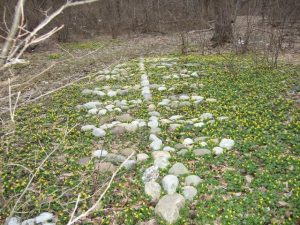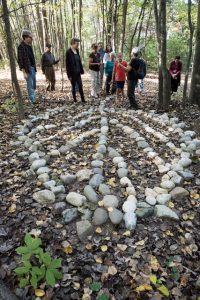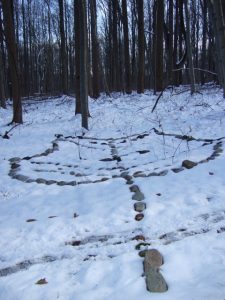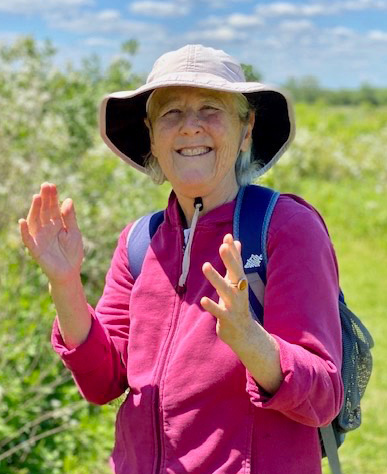For many years, I have walked the trails of the Bunker Hill Environmental Center at Graeber Woods Preserve in Franklin Township, New Jersey observing wildlife. I envisioned how an art project could draw attention to the importance of native trees.
 Eleven ‘stone leaves’ are situated beneath trees outlined with local river stone, basalt, glacial boulder, diabase, goose egg stone and shale. The Belle Mead CO-OP donated riverstone and goose egg stone. Specific leaves required pointed stones for serrated edges, longer stones for the petiole of the leaf or narrow stones for the straight or curved leaf veins. I assembled what I needed, returning many times using a wheelbarrow to transport the stone to the sites. I collected the other stones from different areas of the preserve, gathering shale from the embankment of Simonson’s brook, diabase from remnants of an old stonewall, and glacial boulders at the highest point in the preserve.
Eleven ‘stone leaves’ are situated beneath trees outlined with local river stone, basalt, glacial boulder, diabase, goose egg stone and shale. The Belle Mead CO-OP donated riverstone and goose egg stone. Specific leaves required pointed stones for serrated edges, longer stones for the petiole of the leaf or narrow stones for the straight or curved leaf veins. I assembled what I needed, returning many times using a wheelbarrow to transport the stone to the sites. I collected the other stones from different areas of the preserve, gathering shale from the embankment of Simonson’s brook, diabase from remnants of an old stonewall, and glacial boulders at the highest point in the preserve.
Red Oak, Bigtooth Aspen, American Beech, Black Birch, Tulip Poplar, Shagbark Hickory, Red Maple, Sassafras, Flowering Dogwood, Liberty Elm and Black Walnut leaf sculptures eight to thirty-five feet in diameter are interwoven within the understory of the forest alongside 96 acres of trails that meander through forest, meadow, stream and marsh.
Along the trail
The trail winds through various habitat niches, clearly changing within the understory. Tree species cluster; a grove of Tulip Poplar, a gathering of Black Walnut, a stand of Bigtooth Aspen. Beneath is the lush growth of Spicebush, with leaves that give off a citrony smell when crushed. Birds feed on the small, bright red fruits when they are ripe in the later summer. The larva of the Spicebush Swallowtail Butterfly feed on the leaves. Spicebush grows alongside the invasive Japanese Stiltgrass, competition to the native vegetation. In woodland openings, the native Wood Reed Grass grows in the protective habitat of trees.
Identify the leaf sculptures and the trees they are situated under.
 When groups can congregate once again, I will lead Walking Tours of the leaf sculptures, for students, professionals and people who have never set foot in the forest. The individuals who take this walk will see nature in a new, engaging way. I have exercises along the trail: “Notice the different shapes of the leaves. Find leaves that match the leaf sculptures at each site. Look up at the trees. Are they tall? Are there spaces around the crown? What can you hear? What season is it? What colors are the leaves?” I point out the deciduous trees that reach up to the canopy for sunlight, the forest floor covered with leaf litter where insects, plants and fungi inhabit. We talk about the distinctive feature of a forest ecosystem.
When groups can congregate once again, I will lead Walking Tours of the leaf sculptures, for students, professionals and people who have never set foot in the forest. The individuals who take this walk will see nature in a new, engaging way. I have exercises along the trail: “Notice the different shapes of the leaves. Find leaves that match the leaf sculptures at each site. Look up at the trees. Are they tall? Are there spaces around the crown? What can you hear? What season is it? What colors are the leaves?” I point out the deciduous trees that reach up to the canopy for sunlight, the forest floor covered with leaf litter where insects, plants and fungi inhabit. We talk about the distinctive feature of a forest ecosystem.
Valuable lessons on the Walking Tour
 At the Red Oak and American Beech Leaf Sculpture sites the forest floor is covered with leaves and acorns from a bountiful ‘Mast Year’. Along the trail, I see Red Oak, Pin Oak, Bur Oak, White Oak and Black Oak leaves, with numerous acorns and beechnuts. Further along, I see tall Tulip Poplar trees with bark that has thick, interlacing furrows. The 4-lobed leaves are unusual and turn bright yellow in the autumn. They seem to be scattered throughout the forest with their fruit and seeds. At the Tulip Poplar Leaf Sculpture site delicate saplings of White Ash and Sweet Birch grow in the center of the outlined leaf of riverstone. In the early spring, I saw numerous Cherry Centipedes crawling in the detritus. When I held one up it smelled like cherries!
At the Red Oak and American Beech Leaf Sculpture sites the forest floor is covered with leaves and acorns from a bountiful ‘Mast Year’. Along the trail, I see Red Oak, Pin Oak, Bur Oak, White Oak and Black Oak leaves, with numerous acorns and beechnuts. Further along, I see tall Tulip Poplar trees with bark that has thick, interlacing furrows. The 4-lobed leaves are unusual and turn bright yellow in the autumn. They seem to be scattered throughout the forest with their fruit and seeds. At the Tulip Poplar Leaf Sculpture site delicate saplings of White Ash and Sweet Birch grow in the center of the outlined leaf of riverstone. In the early spring, I saw numerous Cherry Centipedes crawling in the detritus. When I held one up it smelled like cherries!
I love stopping at the Bigtooth Aspen Leaf Sculpture. The aspen trees regenerate vegetatively by shoots arising along shallow lateral roots. This results in many identical trees that share a root structure. The Bigtooth Aspen leaves are unique with a flattened petiole (stem) along the entire length, perpendicular to the leaf blade. The flattened stem allows the leaves to quake or tremble in the slightest breeze. In the spring, Spring Beauty covers the earth in pink at this site.
 One wintery day, I noticed that a solitary Black Birch tree in the center of the Black Birch Leaf Sculpture had fallen! Pileated Woodpecker holes weakened this beautiful old tree and high winds brought it down. I found Carpenter ant galleries inside the tree trunk, a Pileated Woodpecker’s favorite food!
One wintery day, I noticed that a solitary Black Birch tree in the center of the Black Birch Leaf Sculpture had fallen! Pileated Woodpecker holes weakened this beautiful old tree and high winds brought it down. I found Carpenter ant galleries inside the tree trunk, a Pileated Woodpecker’s favorite food!
Deep observation and reflection
“The sculptures become a way of focusing attention in the landscape, a frame that lends additional meaning to its contents, as Susan plucked a wild grape leaf from among the rocks and pointed out the pattern a leaf miner had made through its tissues.” Stephen Hiltner, President at Friend of Herrontown Woods.
Habitat loss may no longer be able to provide the food, water, cover and places to raise young that wildlife needs to survive. Climate change, pollution, invasive species, and disruption of ecosystem processes can no longer support a diverse community.
Emulate a leaf sculpture
Spend time walking in your neighborhood. Identify the species of trees where you live. Find out who owns the land. Collect leaf samples. Make drawings of the leaf you have selected. Identify a location seen from a path or sidewalk. Survey the area to make sure you do not interfere with any wildlife growth. Clear the site of invasive plants, retaining the natives. At the site, use a stick to sketch out your leaf shape on the ground, moving backwards and forwards from key viewpoints to ensure that it is a good size in relation to the space and angles of view. Identify sources of stone- in some places you might not be allowed to move or remove stones from a streambed for instance. Gather stones from the site or a nearby quarry. Use a wheelbarrow to bring the stones to the site. Carefully arrange the stones in the design of the leaf. Look closely and return to the site often at different times of day or season to notice the changes.

Susan Hoenig teaches at the Princeton Arts Council and in Art Out-Reach programs. She is presently artist-in-residence at Mountain Lakes Preserve in Princeton where she is collaborating with Friends of Princeton Open Space to draw attention to the value and beauty of native trees. Susan’s leaf sculptures will be situated alongside newly planted American Chestnut saplings and White Oak trees. Susan currently is in an exhibition with Mary Waltham at the Princeton Public Library, “Wetland to Woodland” (presently closed, but will reopen in the near future) and another exhibition, “Art and Music: Touching Sound” with the Princeton Artist Alliance at the Princeton Arts Council, open in the fall.
